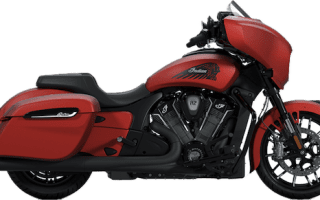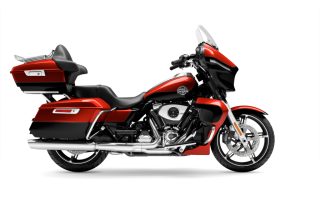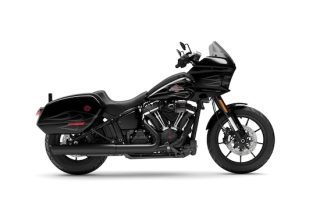 The 2025 lineup from Indian Motorcycles has been officially announced, bringing with it notable updates and upgrades. While these changes don't constitute a complete overhaul, they provide enough innovation to warrant attention. This post dives into the highlights of the lineup, examines how it compares to competitors, and offers a balanced analysis of its pros and cons. (see video below)
The 2025 lineup from Indian Motorcycles has been officially announced, bringing with it notable updates and upgrades. While these changes don't constitute a complete overhaul, they provide enough innovation to warrant attention. This post dives into the highlights of the lineup, examines how it compares to competitors, and offers a balanced analysis of its pros and cons. (see video below)
Key Updates in the 2025 Lineup
The PowerPlus 112 Motor
Indian’s PowerPlus 112 engine is one of the major highlights of the 2025 lineup. Building upon the 108 engine, the 112 boasts a modern design with liquid cooling, overhead cams, and dual throttle bodies. The engine delivers 126 horsepower at 5,500 RPM and 133 ft-lbs of torque at 3,600 RPM, offering enhanced performance and efficiency.
Available in the PowerPlus models like the Chieftain, Challenger, Roadmaster, and Pursuit, this new engine is set to redefine the brand’s touring segment.
SUPPORT US AND SHOP IN THE OFFICIAL LAW ABIDING BIKER STORE
Comparison to Harley-Davidson
The PowerPlus 112's most direct rival is Harley-Davidson's Milwaukee-Eight 117. While the Indian engine outperforms in horsepower, the Harley delivers comparable torque at lower RPMs, giving it a more traditional feel.
 Here’s a quick spec comparison:
Here’s a quick spec comparison:
- Indian PowerPlus 112: 126 HP @ 5,500 RPM; 133 ft-lbs @ 3,600 RPM
- Harley Milwaukee-Eight 117: 105 HP @ 4,600 RPM; 130 ft-lbs @ 3,250 RPM
However, the comparison doesn't stop at raw numbers. Indian’s motor emphasizes a high-revving, performance-oriented experience, while Harley’s engine leans towards traditional low-end torque, catering to riders who prefer a more classic V-twin feel.
Pros of the 2025 Indian Lineup
Advanced Rider Safety Features
 Indian has introduced new rider assist technologies, including:
Indian has introduced new rider assist technologies, including:
- Blind Spot Monitoring: Notifications in the side mirrors or display for safer lane changes.
- Rear Collision Warning: Pulsing rear taillights to alert approaching vehicles.
These features, alongside existing ones like linked braking and hill hold control, enhance rider confidence and safety.
Suspension and Handling Improvements
With 41mm cartridge inverted front forks and a FOX mono-tube rear shock offering electronic preload adjustments (available on select models at a price), Indian's touring bikes promise smoother rides and better handling.
CHECK OUT OUR HUNDREDS OF FREE HELPFUL VIDEOS ON OUR YOUTUBE CHANNEL AND SUBSCRIBE!
Modern Design Meets Heritage
Indian has updated the Batwing fairing with aerodynamic improvements, blending traditional and aggressive styling. This update reduces wind buffeting, ensuring a more stable ride.
Premium Features
- Remote-locking saddlebags and trunk for added convenience.
- Full LED lighting for better visibility.
 LISTEN TO THE LAW ABIDING BIKER PODCAST!
LISTEN TO THE LAW ABIDING BIKER PODCAST!
Cons of the 2025 Indian Lineup
Heat Management Issues
A recurring issue with the previous PowerPlus 108 was excessive heat from the engine, particularly on the inside of a rider's right foot. This could remain a concern for the new 112, although further testing is needed.
Ride Command Infotainment System
Indian's 7-inch Ride Command system remains unchanged, falling behind Harley's fully integrated digital dash (Infotainment Control Unit) introduced in 2024. Riders have noted Ride Command bugs and a less intuitive interface compared to the competition.
Lean Angle and Weight
 aIndian's touring bikes have a lean angle of 31°, slightly less than Harley's 32°. Additionally, the Indian Chieftain PowerPlus weighs 844 lbs, 33 lbs more than the Harley Street Glide. These differences may be negligible for casual riders but could impact handling for those who ride aggressively.
aIndian's touring bikes have a lean angle of 31°, slightly less than Harley's 32°. Additionally, the Indian Chieftain PowerPlus weighs 844 lbs, 33 lbs more than the Harley Street Glide. These differences may be negligible for casual riders but could impact handling for those who ride aggressively.
Pricing Comparison
Pricing plays a significant role in purchase decisions, so here's how the 2025 Indian lineup stacks up against Harley-Davidson:
- Indian Chieftain Limited PowerPlus (112 PowerPlus) (base model/chrome trim): $30,500
- Harley Street Glide (117 M8) (base model/chrome trim): $27,750
The Indian model costs $2,750 more. Similarly, the Indian Challenger Limited PowerPlus costs $30,500, while Harley’s Road Glide is $30,000.
Final Thoughts
The 2025 Indian Motorcycle lineup strikes a balance between tradition and innovation, with standout features like the PowerPlus 112 engine and advanced safety technologies. While it faces stiff competition from Harley-Davidson, Indian continues to push boundaries, ensuring healthy rivalry that ultimately benefits riders.
Stay tuned for more updates as I get hands-on with the 2025 models to bring you a deeper dive into their performance and features.
Join the Free Email Club!
If you appreciate this free information make sure to join the thousands of law abiding bikers that have already joined the free Email Club! You will be notified of new useful motorcycle content and techniques as we put them out. Join the Community now!


















